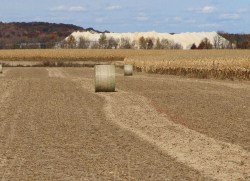
Carol MitchellFrac sand piled up behind a Wisconsin farm.
When most people think about Wisconsin, cheese, breweries, and cornfields spring to mind. But the fracking industry is interested in something else the Badger State has to offer: sand.
A sand-mining boom has gotten rolling in Wisconsin over the last three years. The state’s quartz-based sand is strong and spherical, nicely suited for injecting underground with water and chemicals to prop open cracks in fractured shale, allowing natural gas and oil to be fracked.
The spoils of Wisconsin’s $1 billion frac sand–mining industry are already being hauled by rail to fracking fields as far away as Texas and Pennsylvania. But the sand miners have their sights set higher. At a conference last week, one industry leader said the silica could eventually be shipped to South America and China, helping other countries plunder their own lands for cheap fossil fuels. “Wisconsin is the global epicenter, and we’re just getting started,” said Richard Shearer, president and CEO of Superior Silica Sands. More from The Capital Times:
“I like to say thanks to God and the glaciers” for leaving behind the right kind of sand in Wisconsin, [Republican Gov. Scott] Walker told the receptive audience that included lobbyists, attorneys and rail officials.
Walker’s 2013-15 budget includes two new positions within the Department of Natural Resources to help process applications for sand mining operations, along with investments in freight rail as part of a $6.4 billion package of transportation improvements. …
“I honestly think the sky is the limit for you guys,” said Rayola Dougher, senior economic advisor for the American Petroleum Institute.
The conference attendees seemed much less interested in the impact the sand-mining boom is having on Wisconsin’s residents and environment. The number of mines and processing facilities in the state has risen to more than 100, up from just five in 2010. From an August article in the Milwaukee Journal Sentinel:
The fast-growing sand mining industry is grappling with a rising number of environmental problems across western Wisconsin.
Many of the cases involve water pollution — where vast piles of sand, sediment and dirt have washed off properties, often after heavy rains, and contaminated waterways. …
“It’s really changing the nature of western Wisconsin,” former Natural Resources Board member John Welter told board members in September at a hearing in Eau Claire. …
The cases the [Department of Natural Resources] has referred to the state Department of Justice include an April 2012 accident in Burnett County, where sediment flowed from a site owned by Interstate Energy Partners of Plymouth, Minn., into a wetland, then into a creek and ultimately into the St. Croix River, a federally protected national scenic waterway. …
In another case referred to the Justice Department in spring 2012, a dike collapsed in Blair, in Trempealeau County, “resulting in a river of mud flowing in excess of 2,100 feet, causing extensive damage to private property,” a DNR report shows. The owner, Preferred Sands, headquartered in Radnor, Pa., is accused of failing to prepare and implement a storm-water control plan.
In April of that year, Preferred Sands’ processing plant also violated limits for particle and carbon monoxide pollution.
One day, we would love to write a story about how fracking is helping the environment. But between water contamination, earthquakes, air pollution, deforestation, industrial accidents, and sand mining, that just doesn’t seem likely.



